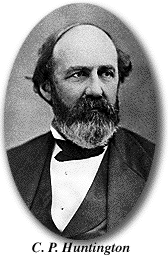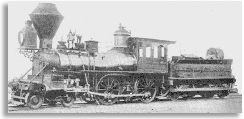Leland Stanford, Collis P. Huntington, Charles Crocker and Mark Hopkins were
the "Big Four" that conceived this enterprise and brought it to a successful
ending after years of daily struggle that would have exhausted the patience and
spirit of ordinary men. Huntington looked after the financing of the company.
Crocker, with his tremendous energy, forced the construction of rails over the
snow- A transcontinental railroad had been dreamed of as early as 1836. From time
to time it was suggested by visionaries and discussed by the orators and
newspapers of the '40s and '50s. In 1853 Congress expended $150,000 in hunting a
feasible route. Surveys were made from time to time. The California Legislature
took a hand in the issue in 1855-6, fearing that Congress might relax its
energies, and urged a speedy construction of a railroad, but the jealousy of
politicians delayed the initiative. Meanwhile short line railroads were
developing in the Middle West. Some of these united, and systems began to
develop.
 The
connection of the Central Pacific and the Union Pacific bridged the 2000 miles
to the Missouri River, and the four to six months time taken by the overland
pioneers was reduced to six days. At once the Pacific States were transformed,
and Western life gradually caught up with the life and aspirations of the East.
The
connection of the Central Pacific and the Union Pacific bridged the 2000 miles
to the Missouri River, and the four to six months time taken by the overland
pioneers was reduced to six days. At once the Pacific States were transformed,
and Western life gradually caught up with the life and aspirations of the East.
 Leland
Stanford is generally given credit for the initiative in starting the
enterprise. In passing the store of Collis P. Huntington in Sacramento, one day,
he noticed one of the huge freight wagons being loaded for the arduous haul over
the Sierra into Nevada. Traffic was developing rapidly, and he realized that a
better carrier and faster service was demanded. He and Huntington talked the
matter over. Mark Hopkins and Charles Crocker were drawn into the discussion;
they all agreed that the time had come for a railroad connection with the East.
Theodore Judah, for whom Judah Street is named, had surveyed a route over the
Sierra and had interested Stanford in its practicability. He was sent for, and
backed with money to go over several surveyed routes known and select the best
one. Meanwhile, the corporation organized with Leland Stanford as president,
C.P. Huntington as vice-
Leland
Stanford is generally given credit for the initiative in starting the
enterprise. In passing the store of Collis P. Huntington in Sacramento, one day,
he noticed one of the huge freight wagons being loaded for the arduous haul over
the Sierra into Nevada. Traffic was developing rapidly, and he realized that a
better carrier and faster service was demanded. He and Huntington talked the
matter over. Mark Hopkins and Charles Crocker were drawn into the discussion;
they all agreed that the time had come for a railroad connection with the East.
Theodore Judah, for whom Judah Street is named, had surveyed a route over the
Sierra and had interested Stanford in its practicability. He was sent for, and
backed with money to go over several surveyed routes known and select the best
one. Meanwhile, the corporation organized with Leland Stanford as president,
C.P. Huntington as vice- This is Central Pacific
locomotive No. 1, the first engine to be placed in construction service on the
western end of the transcontinental railroad. The maiden trip was made at
Sacramento, November 11, 1863, after having arrived from the East on a clipper
ship via Cape Horn. This locomotive was named in honor of Leland Stanford, then
California's governor, and one of the "Big Four" builders of the Central
Pacific.
This is Central Pacific
locomotive No. 1, the first engine to be placed in construction service on the
western end of the transcontinental railroad. The maiden trip was made at
Sacramento, November 11, 1863, after having arrived from the East on a clipper
ship via Cape Horn. This locomotive was named in honor of Leland Stanford, then
California's governor, and one of the "Big Four" builders of the Central
Pacific.


